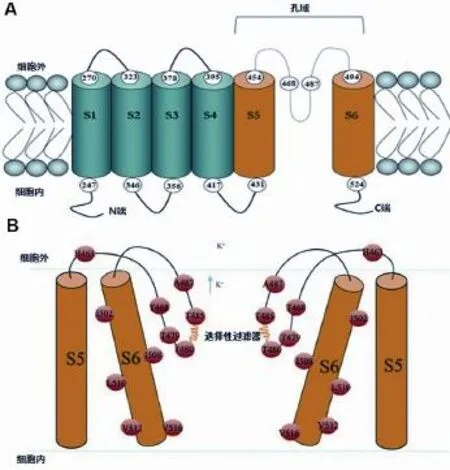Kv1.5钾离子通道阻滞剂的研究进展
董 超,高 洁,翟晓晨,吴 捷
(1.西安交通大学医学部基础医学院药理学系,陕西西安 710061;2.西安交通大学医学部第二附属医院,陕西西安 710004)
·综 述·
Kv1.5钾离子通道阻滞剂的研究进展
董 超1,高 洁2,翟晓晨1,吴 捷1
(1.西安交通大学医学部基础医学院药理学系,陕西西安 710061;2.西安交通大学医学部第二附属医院,陕西西安 710004)
Kv1.5钾离子通道仅在人心房肌中表达,因而特异性Kv1.5通道阻滞剂对心房具有高度选择性,不引发室性心律失常,故极有可能成为未来房颤治疗的新型主导药物之一。研究发现,Kv1.5通道阻滞剂对阵发性、持续性和永久性3种不同类型的房颤均有治疗作用,作用机制主要涉及延长心肌细胞动作电位复极时程和有效不应期。本文就Kv1.5通道的结构特点及其阻滞剂的研究进展进行综述,希望能为新型房颤治疗药物的研发提供一定线索和启示。
Kv1.5通道;钾通道阻滞剂;心房颤动
心房颤动(房颤)是一种临床上常见的心律失常,根据其发作特点分为阵发性、持续性和永久性。文献报道,中国人群的房颤发病率约为0.77%,随着年龄增长发病率逐年升高,80岁以上人群的群体发病率高达7.5%[1]。房颤不仅会引起头晕、心悸等身体不适症状,还会导致心肌梗死、心力衰竭和脑梗死等疾病[2]。目前,房颤的治疗手段主要有导管消融手术、外科消融手术、电复律和药物治疗。其中药物治疗主要用于控制心率、心搏节律和抗凝[3],但总体疗效并不十分理想。对于频繁发作的阵发性房颤,传统治疗药物仅能减少发作次数和发作时间,很难将持续性房颤复转成正常的窦性心律。胺碘酮和多非利特等均存在着严重的不良反应,特别是可引起更为严重的室性心律失常,如危及生命的尖端扭转型室性心动过速(torsade de pointes,TdP)。目前房颤治疗药物研究的最新靶点包括心脏超快速延迟性整流钾离子通道(ultrarapid com⁃ponent of the delayed rectifier K+current,IKur或Kv1.5)和乙酰胆碱激活钾离子通道(acetylcholineactivated K+current,IKACh)[4]。由于这2种靶通道蛋白仅在人心房肌中表达[5],因而它们为房颤选择性治疗药物的研发提供了极有前景的作用靶点。其中属于电压依赖性钾离子通道(Kv)亚型的Kv1.5通道阻滞剂的研发不断涌现,并且已有新药问世。现就Kv1.5钾离子通道阻滞剂的研究进展做一综述。
1 Kv1.5钾离子通道
与其他Kv一样,Kv1.5通道也是主要由4个相同的α亚基以对称的方式围绕而成,中央是离子孔道。每个亚基含6次跨膜α螺旋片段(S1~S6,图1A),S5和S6之间的孔道链接部分、S5和S6部分片段的侧面共同构成一个离子孔道,供钾离子在孔道中流动(图1B)。每个α亚基的氨基(N)端和羧基(C)端位于胞质内。S5和S6之间的孔道链接上存在一个被称为选择性滤器的特殊位置,钾离子就是经此跨细胞膜转运的[6]。
Kv1.5通道的特点是激活迅速,激活后几乎立即出现外向电流。通道电流主要在心房肌细胞动作电位复极的1相和2相起作用,一直持续到动作电位复极的3相,且失活缓慢。房颤发生后,Kv1.5通道蛋白及其编码基因KCNA5在心房中表达出现不同程度的变化。Yamashita等[6]研究表明,阵发性房性心动过速30 min后,大鼠心房中Kv1.5 mRNA表达增多。而Brundel等[7]临床研究发现,持续性房颤患者的心房肌细胞中Kv1.5通道蛋白表达降低。尽管持续性房颤患者心房Kv1.5通道蛋白表达减少,但心肌细胞其他离子通道(如内向型的IL-Ca、IKr和Ito通道蛋白等)也同时减少,其综合后的结果使心房有效不应期(effective refractory period,ERP)和动作电位时程(action potential duration,APD)缩短[5]。此时,阻滞Kv1.5通道仍有可能延长ERP和APD,对抗房颤。

图1 Kv1.5 α亚基的拓扑结构.Kv1.5通道的每个α亚基包含6次跨膜α螺旋片段(S1-S6),N端和C端位于胞质内.孔域是由S5段、S6段以及孔环区(包括选择性滤器)组成(A);Kv1.5通道α亚基2个对立的孔域结构,H463,T468,T479,T480,T485,A487,I502,I508,L510,V512和V516等11个关键氨基酸残基所在的位置(B)。
2 Kv1.5通道阻滞剂作用的分子机制
有学者采用多聚酶链反应为基础的位点变异法对Kv1.5通道构成基因进行人工变异后观察变异通道功能,同时还利用计算机对接模拟软件进行阻滞剂分子与通道拟合分析[4,8-10],结果显示,Kv1.5通道选择性滤器上的T480、通道外嘴上的A487、S6片段上的I502,I508,I512,L510和V516等氨基酸残基是诸多Kv1.5通道阻滞剂潜在的结合位点。Kojima等[8]研究发现,丙泊酚(异丙酚)对T480A,I502A,I508A和V516A等Kv1.5变异通道的阻滞作用显著减弱,表明位于选择性滤器上的T480及S6域的I502,I508和V516这4个氨基酸残基与丙泊酚对Kv1.5通道的阻滞作用密切相关。Bai等[9]观察了花生四烯酸对T462 C,H463C,T479A,T480A,R487V,I502A,A501V,I508A,V512A和 V516A等Kv1.5变异通道的作用,并利用计算机对接模拟软件进行化合物与通道的嵌合分析。结果也印证了位于选择性滤器上的T480、通道外嘴上的A487和S6片段上的I508,I512和V516是花生四烯酸在Kv1.5通道上的结合位点。上述实验结果与我们对化合物LY294002的观察相一致,即LY294002对Kv1.5通道的阻滞作用涉及上述相关位点[10]。
3 阵发性房颤与Kv1.5通道阻滞剂
阵发性房颤的特点是房颤持续时间<48 h,7 d内可自行转复为窦性心律,但会反复发作。频繁发作,则极有可能转变为持续性房颤甚至是永久性房颤。2010年9月获欧洲食品药品监督管理局批准上市的维纳卡兰(vernakalent)是首个用于治疗房颤的Kv1.5通道阻滞剂类药物,临床主要用于持续时间<7 d的非外科术后新发房颤和持续时间<3 d的外科术后新发房颤的转复。英国乔治亚大学和加拿大蒙特利尔大学的2个课题组分别对维纳卡兰等进行的一系列房性心律转复实验[11-12],结果都证明了维纳卡兰比胺碘酮更为安全有效。但研究结果也显示[13-14],维纳卡兰对持续性房颤和永久性房颤患者的治疗效果并不十分理想。
维纳卡兰是一种多离子通道阻滞剂,不仅可选择性地阻滞IKur及IKACh通道,从而延长心房肌细胞的ERP达到转复新发房颤的作用[15]。同时,维纳卡兰还可对钠离子通道产生频率依赖性的阻滞,此作用也有益于消除心房组织的快速颤动。虽然临床已证实维纳卡兰可有效地治疗新发房颤,但考虑到其可能存在的潜在危险,且缺乏大规模长期应用后的临床观测数据,因而美国食品药物管理局(FDA)未批准其在美国上市,该药目前也未进入我国市场。此外,Ford等[16]分别在窦性心律患者和阵发性房颤患者、永久性房颤患者离体右心房小梁上观察了Kv1.5通道阻滞剂XEN-DO103对动作电位的影响。结果发现,XEN-DO103在2~3 Hz高频刺激下可延长阵发性房颤患者心房组织的APD90和ERP。
4 持续性房颤与Kv1.5通道阻滞剂
持续性房颤的特点是房颤持续时间大于48 h,此类患者大多需要电转复或药物转复。目前正在研究的一些Kv1.5通道阻滞剂有望成为治疗持续性房颤的有效药物。其中AZD7009可以延长APD90和ERP,Crijns等[17]的研究表明,给持续性房颤患者静脉注射AZD7009可将持续性房颤患者的心律转为窦性,且转换时间随浓度的增加而缩短,AZD7009 1.5,2.0和2.5 mmol·L-1血药浓度的转换时间分别是62,55和26 min。 Geller等[18]和Aunes等[19]采用双盲对照方法研究表明,静脉注射AZD7009可复转持续性房颤患者心律,且不会引发TdP。不同学者对另一种著名的化合物AVE0118的研究结果显示[20-21],AVE0118可使山羊实验性持续房颤转复率提高至63%,且不引起室性心律失常。其作用被认为主要是通过阻滞IKur和Ito通道从而延长心房不应期来实现的,其对抗房颤的作用或许还与抑制IKACh通道有一定关系[22]。但近期有研究显示,AVE0118延长心房ERP作用与选择性阻滞钠通道有关[23]。
5 永久性房颤与Kv1.5通道阻滞剂
永久性房颤是指不能转复为窦性心律或在转复后24 h内复发者。该类房颤患者心房不像正常人一样有规律的搏动,而是表现为持续不规则颤动。对永久性房颤的治疗主要以控制心室频率为主,同时还要辅以抗凝治疗。Ford等[16]在永久性房颤患者离体右心房小梁上观察到Kv1.5通道阻滞剂XEN-DO103可延长永久性房颤患者心房APD90和ERP,不论是1 Hz还是2~3 Hz刺激频率,均有此作用。采用随机双盲实验进一步观察XEN-DO103对正常人心电图的影响,结果并未发现QTc出现异常。Loose等[24]分别观察了Kv1.5通道阻滞剂MK-0448对永久性房颤患者、阵发性房颤患者和窦性心律患者右心房小梁动作电位的影响,结果发现,MK-0448可使永久性房颤患者右心房小梁APD90及ERP延长。上述结果提示,Kv1.5通道阻滞剂对永久性房颤具有治疗作用,但结果还有待临床观察验证。
6 结语
由于Kv1.5通道蛋白仅在人心房中表达,使得Kv1.5通道作为一种房颤治疗的新靶点受到很多学者推崇。研究发现,化学结构有很大差异的多种化合物都存在Kv1.5通道阻滞作用,如糖皮质激素[25]、抗抑郁药[26-27]、吲哚衍生物[28]、1-芳氧哌嗪衍生物[29]、四氢萘芳基磺酰胺[30]、二苯基磷酰胺和二苯基磷氧化物[31]、苯氨基杂环化合物[32]、异吲哚啉酮类化合物[33]、杨梅酮[34]和异糖精胺[35]。目前已知的大多数化合物对Kv1.5通道的阻滞剂作用与它们对Kv1.5通道S6片段或选择性滤器上的位点的影响有关。离体心房观察发现,它们均可选择性地延长心房APD90和ERP。由于大多数化合物对多种心脏离子通道具有阻滞作用,因而其延长心房APD90和ERP的作用也有可能是通过非Kv1.5通道阻滞作用或同时影响多种离子通道来实现的[24]。尽管Kv1.5通道阻滞剂的作用存在一定争议[4-5],但有关新化合物的研究仍持续受到热点关注。当然,作为一种极具发展前景的新型房颤治疗药物,Kv1.5通道阻滞剂的研发目前也面临着很大挑战:①现有的大多数Kv1.5通道阻滞剂为多通道阻滞剂,特异性并不十分理想;②大多数Kv1.5阻滞剂的作用都是通过离体心肌组织、转基因细胞或动物房颤模型筛选出来的,对人体治疗效果如何还有待进一步的临床观察;③已在欧洲上市的首个Kv1.5通道阻滞剂维纳卡兰缺乏大规模长期临床观察数据,作为同类药物的先导者需要进一步对其疗效和安全性进行评价;④Kv1.5晶体尚未合成,目前计算机对接模拟主要使用的是Kv1.2或Kv1.3的晶体结构,可能对新阻滞剂的研发有一定影响。
[1]Zhou ZQ,Hu DY,Chen J.Interpretation of the re⁃sults of epidemiological study of atrial fibrillation in China[J].Chin J Intern Med(中华内科杂志),2010,49(3):198-199.
[2]Bie LC,Zhao DD,Huang CK,Chen R,Hong J. The status and research progress in the epidemiology of atrial fibrillation[J].Prog Mod Biomed(现代生物医学进展),2015,15(13):2562-2568.
[3]Zhong GZ.The status and prospect on diagnosis and treatment of atrial fibrillation[J].J Pract Med(实用医学杂志),2015,31(6):872-875.
[4]SchmittN,GrunnetM,OlesenSP.Cardiac potassium channel subtypes:new roles in repolar⁃ization and arrhythmia[J].Physiol Rev,2014,94(2):609-653.
[5]Dobrev D,Carlsson L,Nattel S.Novel molecular targets for atrial fibrillation therapy[J].Nat Rev Drug Discov,2012,11(4):275-291.
[6]Yamashita T,Murakawa Y,Hayami N,Fukui Ei,Kasaoka Y,Inoue M,et al.Short-term effects of rapid pacing on mRNA level of voltage-dependent K+channels in rat atrium:electrical remodeling inparoxysmalatrialtachycardia[J].Circulation,2000,101(16):2007-2014.
[7]BrundelBJ, Van GelderIC,HenningRH,Tieleman RG,Tuinenburg AE,Wietses M,et al. Ion channel remodeling is related to intraoperative atrial effective refractory periods in patients with paroxysmal and persistent atrial fibrillation[J].Circulation,2001,103(5):684-690.
[8]Kojima A,Ito Y,Ding WG,Kitagawa H,Matsuura H. Interaction of propofol with voltage-gated human Kv1.5 channel through specific amino acids within the pore region[J].Eur J Pharmacol,2015,764:622-632.
[9]Bai JY,Ding WG,Kojima A,Seto T,Matsuura H. Putative binding sites for arachidonic acid on the human cardiac Kv1.5 channel[J].Br J Pharmacol,2015,172(22):5281-5292.
[10]Wu J,Ding WG,Matsuura H,Tsuji K,Zang WJ,Horie M.Inhibitory actions of the phosphatidylinositol 3-kinase inhibitor LY294002 on the human Kv1.5 channel[J].Br J Pharmacol,2009,156(2):377-387.
[11]Camm AJ,Capucci A,Hohnloser SH,Torp-Pedersen C,Van Gelder IC,Mangal B,et al.A randomized active-controlled study comparing the efficacy and safety of vernakalant to amiodarone in recentonset atrial fibrillation[J].J Am Coll Cardiol,2011,57(3):313-321.
[12]Roy D,Pratt CM,Torp-Pedersen C,Wyse DG,Toft E,Juul-Moller S,et al.Vernakalant hydrochlo⁃ride for rapid conversion of atrial fibrillation:a phase 3,randomized,placebo-controlled trial[J].Circulation,2008,117(12):1518-1525.
[13]Pratt CM,Roy D,Torp-Pedersen C,Wyse DG,Toft E,Juul-Moller S,et al.Usefulness of vernaka⁃lant hydrochloride injection for rapid conversion of atrial fibrillation[J].Am J Cardiol,2010,106(9):1277-1283.
[14] Wettwer E,Christ T,Endig S,Rozmaritsa N,Matschke K,Lynch JJ,et al.The new antiarrhythmic drug vernakalant:ex vivostudy of human atri⁃al tissue from sinus rhythm and chronic atrial fibril⁃lation[J].Cardiovasc Res,2013,98(1):145-154.
[15]Ma CS,Chen K.Progress toward the clinical application of vernakalant:a new antiarrhythmic agent[J].Chin J New Drugs(中国新药杂志),2012,21(15):1752-1755.
[16]Ford J,Milnes J,El Haou S,Wettwer E,Loose S,Matschke K,et al.The positive frequency-depen⁃dent electrophysiological effects of theIKurinhibitor XEN-D0103 are desirable for the treatment of atrial fibrillation[J].Heart Rhythm,2016,13(2):555-564.
[17]CrijnsHJ, VanGelderIC, WalfridssonH,Kulakowski P,Rónaszéki A,Dedek V,et al.Safe and effective conversion of persistent atrial fibrilla⁃tion to sinus rhythm by intravenous AZD7009[J].Heart Rhythm,2006,3(11):1321-1331.
[18]Geller JC,Egstrup K,Kulakowski P,Rosenqvist M,Jansson MA,Berggren A,et al.Rapid conversion of persistent atrial fibrillation to sinus rhythm by intravenousAZD7009[J].JClinPharmacol,2009,49(3):312-322.
[19]Aunes M,Egstrup K,Frison L,Berggren A,Stridh M,Sörnmo L,et al.Rapid slowing of the atrial fibrillatory rate after administration of AZD7009 predicts conversion of atrial fibrillation[J].J Electrocardiol,2014,47(3):316-323.
[20]Blaauw Y,Gögelein H,Tieleman RG,Van Hunnik A,Schotten U,Allessie MA.“Early”classⅢ drugs for the treatment of atrial fibrillation:efficacy and atrial selectivity of AVE0118 in remodeled atria of the goat[J].Circulation,2004,110(13):1717-1724.
[21]De Haan S,Greiser M,Harks E,Blaauw Y,Van Hunnik A,Verheule S,et al.AVE0118,blocker of the transient outward currentItoand ultrarapid delayed rectifier currentIKur,fully restores atrial contractility after cardioversion of atrial fibrillation in the goat[J].Circulation,2006,114(12):1234-1242.
[22] Voigt N,Rozmaritsa N,Trausch A,Zimniak T,Christ T,Wettwer E,et al.Inhibition ofIKAChcur⁃rent may contribute to clinical efficacy of classⅠand classⅢantiarrhythmic drugs in patients with atrial fibrillation[J].Naunyn Schmiedebergs Arch Pharmacol,2010,381(3):251-259.
[23]Burashnikov A,Barajas-Martinez H,Hu D,Nof E,Blazek J,Antzelevitch C.Atrial-selective prolonga⁃tion of refractory period with AVE0118 is due princi⁃pally to inhibition of sodium channel activity[J].J CardiovascPharmacol,2012,59(6):539-546.
[24]Loose S,Mueller J,Wettwer E,Knaut M,Ford J,Milnes J,et al.Effects ofIKurblocker MK-0448 on human right atrial action potentials from patients in sinus rhythm and in permanent atrial fibrillation[J].Front Pharmacol,2014,5:26.
[25]Yu J,Park MH,Jo SH.Inhibitory effects of corti⁃sone and hydrocortisone on human Kv1.5 channel currents[J].Eur J Pharmacol,2015,746:158-166.
[26]Lee HM,Hahn SJ,Choi BH.Blockade of Kv1.5channels by the antidepressant drug sertraline[J].KoreanJPhysiolPharmacol,2016,20(2):193-200.
[27]Lee HM,Hahn SJ,Choi BH.Blockade of Kv1.5 by paroxetine,an antidepressant drug[J].Korean J Physiol Pharmacol,2016,20(1):75-82.
[28]Guo X,Yang Q,Xu J,Zhang L,Chu H,Yu P,et al.Design and bio-evaluation of indole deriva⁃tives as potent Kv1.5 inhibitors[J].Bioorg Med Chem,2013,21(21):6466-6476.
[29]Guo X,Ma X,Yang Q,Xu J,Huang L,Jia J,et al.Discovery of 1-aryloxyethyl piperazine deriva⁃tives as Kv1.5 potassium channel inhibitors(part I)[J].Eur J Med Chem,2014,81:89-94.
[30]Gross MF,Castle NA,Zou A,Wickenden AD,Yu W,Spear KL.Aryl sulfonamido tetralin inhibitors of the Kv1.5 ion channel[J].Bioorg Med Chem Lett,2009,19(11):3063-3066.
[31]Olsson RI,Jacobson I,Boström J,Fex T,Björe A,Olsson C,et al.Synthesis and evaluation of diphe⁃ nylphosphinic amides and diphenylphosphine oxides as inhibitors of Kv1.5[J].Bioorg Med Chem Lett,2013,23(3):706-710.
[32]Johnson JA,Xu N,Jeon Y,Finlay HJ,Kover A,Conder ML,et al.Design,synthesis and evalua⁃tion ofphenethylaminoheterocycles as Kv1.5 inhibitors[J].Bioorg Med Chem Lett,2014,24(14):3018-3022.
[33] Kajanus J,Jacobson I,Åstrand A,Olsson RI,Gran U,Björe A,et al.Isoindolinone compounds active as Kv1.5 blockers identified using a multi⁃component reaction approach[J].Bioorg Med Chem Lett,2016,26(8):2023-2029.
[34]Ou X,Bin X,Wang L,Li M,Yang Y,Fan X,et al. Myricetin inhibits Kv1.5 channels in HEK293 cells[J].Mol Med Rep,2016,13(2):1725-1731.
[35]Lloyd J,Finlay HJ,Kover A,Johnson J,Pi Z,Jiang J,et al.Pseudosaccharin amines as potent and selective Kv1.5 blockers[J].Bioorg Med Chem Lett,2015,25(21):4983-4986.
Research progress in Kv1.5 channel blockers
DONG Chao1,GAO Jie2,ZHAI Xiao-chen1,WU Jie1
(1.Department of Pharmacology,School of Basic Medical Science,Xi′an Jiaotong University,Xi′an 710061,China;2.Second Affiliated Hospital,School of Basic Medical Science,Xi′an Jiaotong University,Xi′an 710004,China)
The Kv1.5 potassium channel is only expressed in human atrial myocytes,so specific Kv1.5 channel blockers have high selectivity to atria and will not trigger ventricular arrhythmias.There⁃fore,Kv1.5 channel blockers are likely to become a new leading drug for atrial fibrillation(AF)treat⁃ment in the future.Literature has revealed that Kv1.5 channel blockers have therapeutic effect on all the three types of AF:paroxysmal,persistent,and permanent.The mechanisms underlying the AF treatment by Kv1.5 channel blockers are probably related to the prolongation of the action potential du⁃ration and effective refractory period in atrial myocytes.In the present paper,we briefly described the structural characteristics of Kv1.5 channel and reviewed the research progress in Kv1.5 channel block⁃ers,hoping to provide some clues for the study and development of new AF therapeutics.
Kv1.5 channel;potassium channel blockers;atrial fibrillation
WU Jie,E-mail:wujie@mail.xjtu.edu.cn,Tel:(029)82655165
R966
A
1000-3002(-2016)10-1097-05
10.3867/j.issn.1000-3002.2016.10.002
Foundation item:The project supported by National Natural Science Foundation of China(81273501);and National Natural Science Foundation of China(81470378)
2016-04-05 接受日期:2016-08-01)
(本文编辑:乔 虹)
国家自然科学基金(81273501);国家自然科学基金(81470378)
董 超,女,硕士研究生,主要从事心血管药理学研究;吴 捷,男,博士,教授,主要从事心血管药理学研究。
吴 捷,E-mail:wujie@mail.xjtu.edu.cn,Tel:(029)82655165

